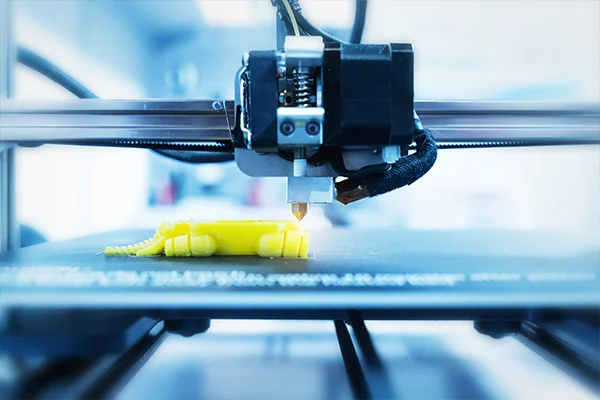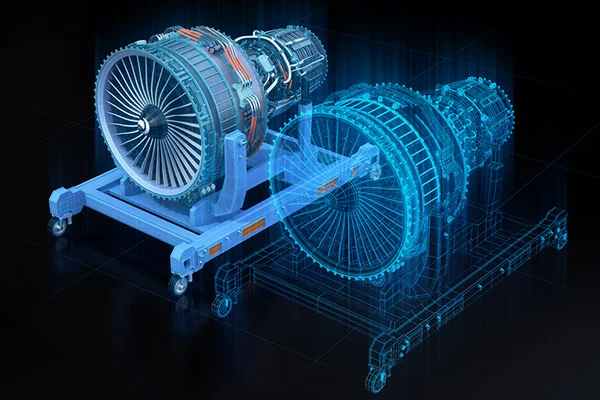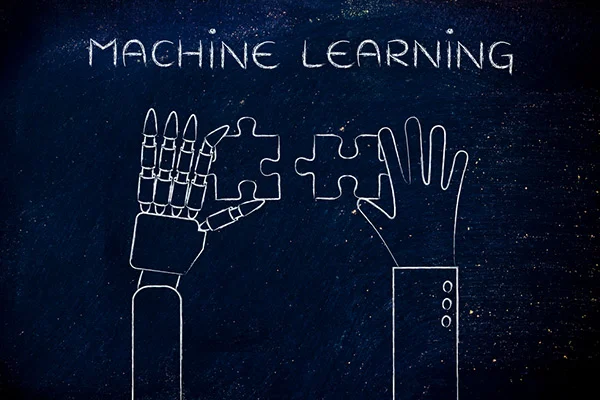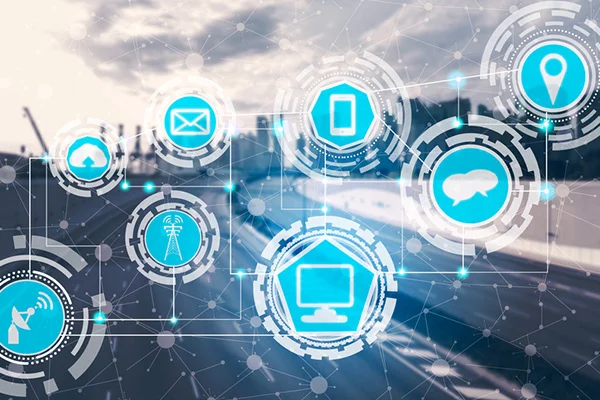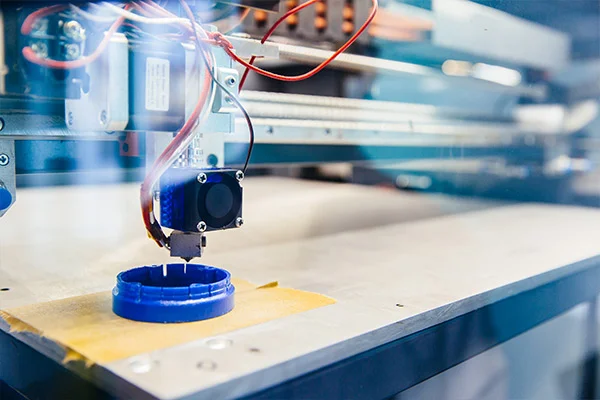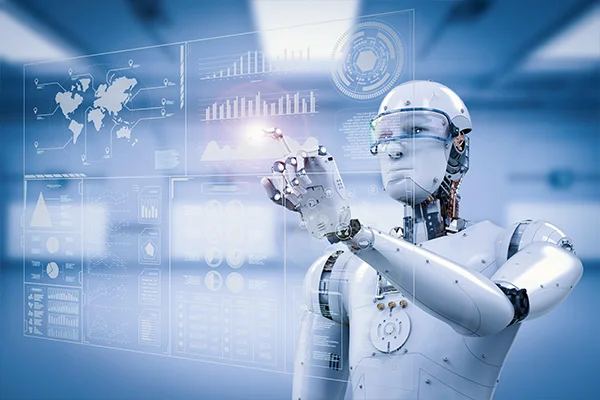How Artificial Intelligence and 3D Printing can collaborate
Artificial Intelligence 3D Printing Machine Learning Applications of AI in 3D printing AI and 3D printing has been a hot tech for sometime and ever since their inception, these two domains has climbed steadfastly on the global market ladder. The 2019-20 global automation market size has displayed this rise. It is obvious that these two domain would cross paths sometime and strike up a beneficial collaboration. The intersection of AI and 3D printing has long been predicted. AI can analyze a 3D model and determine which parts will fail to form the part. 3D printers can also remove material from failed regions and use AI to create a different version. AI can even analyze a part’s geometry and identify a potential problem so an alternative way to create it can be found. The end result? A better-designed part with a high rate of success. Artificial Intelligence The merging of artificial intelligence and 3D printing is an evolution of manufacturing paradigms. Prosthetics design, for instance, is one of the most important applications of 3D printing. As technology advances, artificial intelligence and 3D printers can be used to control 3D printers and increase the number of compatible materials for the process. By combining these two technologies, manufacturers can create new and improved products and production processes. Artificial intelligence and 3D printing will eventually help humans create better prosthetics. The advancement of 3D printing has made it possible to create complex objects without the need for a human. Despite the complexity of the manufacturing process, AI can help to improve the process. The combination of AI and 3D printers will also create new applications. Here are some applications that will benefit from the convergence of these technologies. Once this technology becomes more widespread, it will revolutionize the manufacturing industry. It could even be used to create new prosthetic limbs that can be used for surgery. 3D Printing AI and 3D printing are often associated, but it can also be used to create better products and objects. By automating processes, AI can help eliminate human error and enhance 3D printing performance. The fusion of AI and 3D printing has a number of benefits for manufacturing and quality control. It also helps accelerate the rise of Industry 4.0 and the Industrial Internet of Things. But which use cases will AI have in manufacturing? What are some examples of where AI is already being applied to 3D printing? Machine learning, or AI, is a technology that can analyze a data stream and find hidden relationships. For instance, in the 3D printing process, artificial intelligence helps maintain the material properties of complex alloys, such as titanium, carbon, and other metals. The resulting models can be used for predictive maintenance. Machine learning can even help manufacturers improve spare parts and predict when to replace them. This is an exciting development for manufacturers and researchers alike. Machine Learning Bioprinting, also known as 3D bioprinting, is an emerging field in which machine learning is being used to improve the process of making organoids. This technique involves constructing a scaffold with a specific design to support cell growth and function. The complexity of the scaffold can have a big impact on the printed organ’s function. For this reason, scaffolds should be designed carefully and precisely to optimize the process. Using machine learning in 3-D bioprinting can help detect defects, such as incorrectly positioned cells, curved layers, and microstructure errors. It can also monitor the entire bioprinting process and identify problems before they arise. One such example is shown in Figure 4, which uses CNN to detect defects during the bioprinting process. In this example, images from high-quality cameras during the bioprinting process are input data for the CNN, which analyzes the images to determine whether they are defects. Applications of AI in 3D printing AI has a number of advantages when it comes to 3D printing, including the ability to analyze an object before starting the process, and to predict the quality of the part. The use of machine learning algorithms also improves the fixation process and reduces manufacturing waste. Some projects are even aiming for zero-waste additive manufacturing. AI can also be used to protect important data about the printing process, such as reducing the number of errors. A recent example of an application of machine learning in 3D printing is automated monitoring of 3D printed parts. By integrating image processing and camera data, supervised machine learning algorithms can detect defects during the printing process and help companies fix them without human intervention. The technology can also help companies cut the cost of reprinting parts if they have to fix a problem. Another cost-saving application of artificial intelligence in 3D printing is the guarantee of high- precision prints. A project developed by the University of Southern California has been designed to ensure that parts produced by 3D printing processes meet high-quality standards. The possibilities for AI and 3D printing to collaborate are endless. We’ve seen how they can work together to create a prosthetic hand, and we believe that as these technologies continue to develop, the potential value they can provide each other will only increase.
Read MoreAdditive Manufacturing the rise of metals in 3D printing
Table of content Plastic as the basis for 3D printing Metal as the basis of 3D printing Additive manufacturing is one of the advanced techniques of Industry 4.0 that can manufacture industrial products faster and more precisely as compared to traditional manufacturing processes. Also known as 3D printing, it is a technique that works by turning a digital model of an object into a three-dimensional physical item by adding printable materials layer by layer on its digital design. It helps create complex geometrical patterns that are not possible with traditional manufacturing methods, designing and making lighter components, and controlling various material properties such as density and stiffness. 3D printing has gained popularity rapidly, involving minor prototype construction, fewer dies, and less post-processing. The aerospace and defense industry is experiencing large-scale use of 3D printing with French company Thales Group started a global center of expertise in additive manufacturing in Morocco in 2017. Boeing created its first 3D printed metal satellite antenna for the Israeli company Spacecom in 2019. Airbus used the technology to manufacture the titanium 3D printed bracket on an in series production A350 XWB commercial aircraft in 2017 and has since announced plans to develop 3D printed drones. Plastic as the basis for 3D printing Stereolithography (SLA): SLA is the first 3D printing technology ever used. It hardens a liquid resin using an ultraviolet beam, bonding each successive layer. Despite its antiquity, this technology is still widely used mainly due to a few advantages such as detail resolution, surface quality, and tight tolerances. It is used for UV-sensitive epoxy resins and ceramic-reinforced materials (NanoTool, BlueStone, CeraMax). This technique is widely used for coupling tests, dimensional verification, ergonomic studies, and wind tunnel aerodynamics tests due to its high detail resolution. Fused filament fabrication (FFF): In this process, melted thermoplastic material such as plastic, wax, or metal is sprayed from a nozzle to create many layers, each of which are bonded to the other. The bonding is done mainly by heat or adhesion. The most popular metals used here are nylon, high-density polyethylene, polycaprolactone, polycarbonate, and low melting point metals. Due to its affordability, FFF is a commonly used process for rapid prototyping parts with standard tolerances. Selective laser sintering (SLS): SLS involves hardening and bonding tiny seeds of plastic into layers in a three-dimensional structure using a laser. The powder is jet sprayed from multiple nozzles on the print area, and then the laser fuses or sinters the powder layer by layer. Based on the requirement, SLS printed objects are commonly made with plastic materials, such as nylon or any other powdered material. One of the main benefits of this technique is that, unlike many other 3D printing technologies, SLS doesn’t require much tooling once an object is printed.Unlike stereolithography, SLS doesn’t need additional supports to clasp a thing while it is being printed. Electron beam melting (EBM): Like SLS, EBM is a process that requires high energy high temperature, just that it uses an electron beam as its power source. In this, a tungsten filament in the electron beam gun is superheated to create a cloud of electrons that accelerate to approximately one-half the speed of light. A magnetic field focuses the beam to the desired diameter, while the second magnetic field directs the beam of electrons to the desired spot on the print bed. Currently, EBM is required mainly for producing refractory and reactive metals (titanium, niobium, zirconium, tantalum, etc.) and their alloys. EBM is great for melting and refining metals and alloys in water-cooled copper molds under a high vacuum. Laminated object manufacturing (LOM): Introduced by Cubic Technologies (formerly Helisys Inc.), LOM is a quick and comparatively cheaper method of 3D printing objects in various materials such as metals, plastics, or paper. It binds sheets in successive layers then cuts into the desired according to the 3D CAD model. It is a prototype-centric technique and is not used for production. Metal as the basis of 3D printing While 3D printing started by using mainly plastic as the base material, metal additive manufacturing technologies are currently the most significant growth area for additive manufacturing and include: Selective laser melting (SLM): A laser is used to melt successive layers of metallic powder until completely melted. The machine then adds additional layers of powder over the melted layer until the object is built. The aerospace and medical devices industries have witnessed the maximum use of this technology, as the manufacturing in those industries involves complex parts that can be simplified using this process. This technology was discovered in 1995 by the German research institute Fraunhofer Institute ITL. Direct Metal Laser Sintering (DMLS): Developed jointly by Rapid Product Innovations (RPI) and EOS GmbH, this technique is like SLM. The main difference is the degree to which the particles are melted. In DMLS, the particles are not completely melted. Also, the 3D printer parts are developed from excellent Aluminium or Titanium powder. Laser metal disposition (LMD): Laser Metal Disposition is also called directed energy deposition (DED). In this, a laser beam melts the metallic object and creates a pool into which the powder is fed. The powder then melts to form a deposit, and the required geometry is achieved layer by layer. The powder emitting laser and nozzle are controlled using a motion- centric system or robotic arm. This technology has been rapidly gaining traction in industries such as aerospace, tooling, transportation, and oil and gas. Electron beam melting (EBM): Originally patented and developed by the Swedish company Arcam, EBM differs from other techniques as it uses an electron beam as a power source instead of a laser to 3D print metal. The beam fully melts down the metal powder layer by layer in a high vacuum while retaining the original characteristics of the material. The technique can manufacture metal parts with 100% density and is also helpful for industries with complex components such as aerospace and medical implants.
Read MoreCombine Product Digital Twin and Product Configurator for Faster Product
By Swanand Javadekar A digital twin is a dynamic representation of an asset that allows us to understand the better working of the system and predict performance for better design directions. A product configurator is a dynamic representation of the CAD model that allows us to build an intelligent, practical model to enhance the speed of design and development. This paper conceives the concept and applies it to functional scenarios for better understanding and elaboration. Let us quickly elaborate on both the concepts and explore further for combined application: Product Configurator Product Configurator is a single solution that can, Essentially, it’s a solution that helps you get more customers and dramatically increases the productivity of your sales and design team. A product configurator is a design automation solution that works on parameter-driven design. We can create a complete model on the fly by entering a few key parameters. Our Product Configurator solution is based on proven and tested CAD neutral architecture. Hence we can work with the CAD system you use (NX, SolidEdge, SolidWorks, Creo (Pro/E), AutoCAD, Autodesk Inventor, and others). Digital Twin As mentioned earlier, a digital twin is a virtual representation of an actual world entity or a system to understand product behavior better. Generally, we can divide digital twin into three categories: Case Study: Industrial Engineering (Elevator) The product configurator and the digital twin have applications at various levels, typically in operations, commissioning, and installations. If we divide elevator methods and processes into three categories: Install, Operate, Maintain, we will elaborate areas where the standard approach will be helpful. Product configurator can be used to build a CAD model based on available configuration parameters such as allotted space, cage parameters, and internal and external dimensions. The cad model will be ready based upon various options, which can be easily used further for manufacturing drawings or product validation. Once your multiple models are available, the same can be used for further meshing and validation to pick the best-suited configuration. We can calculate the remaining useful life (RUL) and any what-if scenario. With confirmation from the product validation exercise, the final model can be used for further AR/VR exercise for product visualization purposes. Product configurator and digital twin combination will provide faster product development; the final product can also be used for further downstream applications such as AR/VR. Not only does the product manufacturer benefit by delivering a superior product, but other supporting systems such as building, and infrastructure management will benefit from the optimized maintenance cost and less downtime. Case Study: Industrial Engineering (Furniture) The furniture industry is an exciting example involving engineering with style and substance. The customer is demanding in terms of various options or variants, and the possibilities are endless. It’s where science meets the art, and probabilities are limitless. If we take the example of a simple chair, the flow chart is quite exhaustive: Type Base Features executive 5-star base high back conference 4-star base low back dining wood leg headrest auditorium sled base tablet soft stools stackable meeting swivel visitor adjustable plain sitting All the combinations come with the additional complexity of colors, mesh size, etc. In such a case where the manufacturer provides exhaustive options, and customers make customizable chairs, a combination of Product configurator and digital twin offers dynamic support to realize the dream. The CAD model of a chair combination is made faster while tested with the furniture industry-standard of weights. Any unique composite structure design or material changes can also be realized quickly. It allows the manufacturer to release the product faster to customer delight. Combining Product configurator and digital twin is the way forward as it allows manufacturers to manufacture faster to market methodology and offers customers to choose from a wide variety of options leading to customer delight.
Read MoreSmart Machines & Solutions for Smarter Performance
By Swanand Jawadekar Today, smart machines have become one of the integral parts of smart factories leading to the Industry 4.0 revolution. This paper details solutions developed for special purpose machines such as cartooning machines, tube filling machines and can be extended to similar types of SPM’s. These machines perform specialized manufacturing operations and are integral parts of agriculture, pharmaceutical or industrial factories. The Solution capitalizes on the readily generated engineering data in conjunction with loT (Internet of things) and AR (Augmented Reality) to make the machine smarter in a connected environment. It uses operating data from the equipment to predict various functional parameters such as production and performance analysis, energy analytics, delivering new insights towards Overall Equipment Effectiveness (OEE). Design and Development: Critical Foundation Today, the Digital twin has become an integral part of the manufacturing process. It can be characterized as a digital representation of the physical asset, which enables additional insight into machines’ performance. Besides supporting design strength analysis, it provides tools to examine the operating mechanism, loads and boundary condition, failure studies, alternate material. Carrying out a mechanism’s kinematic analysis involves calculating the velocity, location, and acceleration of any of its points or links for the prescribed time step. The study helps the user understand the mechanism’s behavior and make changes in geometry, material, and improve product performance. For any machine performance evaluation, mechanisms play a critical role. From material entry to final product manufacture, there are various mechanisms involved, consisting of combinations of conveyers, Cam, and rollers. Apart from analyzing critical mechanism parameters, Digital twin can be effectively used to identify influential data parameters affecting machine performance which can be further monitored using loT Techniques. The parameter identification will help the user effectively use sensors, location, and data acquisition and connect to the mobile portal. Once the critical parameter has been identified and equipped with sensors, they can measure the real-time mechanical or heat load which the machine experience in real life. Based upon received data, one can predict component failure, and the same can be replaced much before the break or worn out. Data Anytime / Anywhere Currently, most customers are looking towards intuitive products, easy to interact with, and high on performance parameters. Smart machines effectively use loT tools and parameters identified from Design simulations to provide a robust tracking mechanism. As determined by validation studies, critical machine design parameters can be further monitored to achieve better insight into machine performance. The performance tracker data can be accessed from a remote location and enhances the support system’s reach. IoT also helps the customer for a better post-sale experience and optimized environment. Following are some of the typical machine performance parameters which can be tracked live: Augmented Reality Augmented reality is gaining momentum in the marketplace and has shown incredible potential to support enterprise activities with different departments to perform their operations efficiently. It promotes a converged experience for the 3D AR content to Visualize, Instruct, simulate the working environment. The approach embeds desired parameters from the loT platform in the AR experience helps visualize a machine’s real-time information. AR studies can further be synched with various levels of an organization as illustrated below: In the Nutshell Design engineering has evolved dramatically. From draft board design to Computer-Aided Design and modeling to virtual reality, it has crossed global boundaries. With old proven CAD techniques and new Data, AR/VR (augmented and virtual reality) tools, we support international customers to build their design faster, better, and accessible / monitor from remote locations. These solutions extend flexibility to the customer and bring the global design team to work together towards standard global.
Read MoreFuture of Product Design in the Era of Smart Connect!
By Swanand Javadekar Preface The automotive industry has been facing a daunted set of challenges with upcoming connected cars, autonomous driving, and electric vehicles. It is an opportunity to differentiate for the right minds by bringing the right mix of solutions to the customer and enlightening them with more intelligent products. The following paper highlights the association of technology trends to design connected products and build efficient ecosystems for execution. Some of the aspects discussed are Trends There are various ways technology is changing product outlook, following are some of the exciting trends influencing product design and development cycle: Smart Products: 4 promoting factors Today, Smart Products have become one of the integral parts of our life. It changes the way we use products and generates new business models. This paper details layout developed to build intelligent products and discusses the contribution and trends in each sector. The discussion is limited to product design and development and not extended to manufacturing 4.0. In a connected environment, smart products use the basic engineering data in conjunction with loT (Internet of things) / AR (Augmented Reality), embedded systems, and data analytics to provide better insight to the user and a machine manufacturer. It uses operating data from the equipment and uses a feedback loop effectively to predict various functional parameters related to product performance. Designing smart products As a designer who builds innovative products, he uses various advanced tools such as MBD (model- based engineering) and DEM (differential element method) to generate better insight into component behavior. Digital twin, which generates buzz across the engineering community, is a virtual replica of a product containing representative mechanical, electrical, electronic, and performance configuration information. The digital twin is not new, as the design community is already using various CAD, CAE, and CAM tools for the past few years. However, it has witnessed changes in the ability to collect, collate and analyze big data, work towards finding trends, anomalies and use the feedback loop back to design context to make it robust. Building digital twin also leads to effectively monitoring data, leading to building newer business models. Simulation is also one of the data-driven tools extensively used to analyze components, from simple durability to complex crash simulation. With higher computing power, the data handling capacity has been increased, as it can handle complete vehicle analysis compared to component level validation. Today, ROM (reduced-order method) based models have been used, which are machine learning solutions for reducing the size of a data set while preserving the essential parts of the information contained within that data. Such an approach now supports the user to analyze the components for rapid execution, reducing the total number of runs. There are various methods for which data analysis techniques are used: fault detection, predictive maintenance, statistical monitoring, real-time crash, and safety. Designing connected products: AR/VR Today AR/VR is playing a significant role in automotive product design and development. Typically, AR/VR can be extensively used for design and development, manufacturing, marketing, training, and servicing. More usage of these techniques is applied towards manufacturing and marketing, but the practice of product design is on the rise. Someone can effectively use these techniques used for design reviews and revision comparison. With the latest external devices such as hololens available in the market, the user can get an immersed view of the design for detailed assessment. Designing Embedded products: ADAS It’s exciting to note how these four verticals complement each other for product feature enhancement. Let’s take the example of embedded system / ADAS (advanced driver-assisted systems). We have seen that, typically, engineering simulation has been used for product development and digital twins, but the usage can be extended towards ADAS development. Some of the scenarios where validation tools can support to improve product performance understanding are semiconductor simulation (reliability analysis of Printed circuit board, energy consumption), sensor simulation (radar pattern simulation, placement of sensors compared to signal integrity), and driving scenario (software algorithm modeling simulation) Designing insightful products We know that Data analytics tools are effectively used for supply chain optimization, marketing mix analysis, user and dealer satisfaction, and customer behavior analysis. How can it be effectively used for a designer to view insight at an early stage? Today product designers are facing challenges towards converting data to actionable insights. The designer will work on three types of data, design data (based upon engineering calculations), test or proving data (standard vehicle test data), and real-life running data (received via various sensors loaded at designer vehicle test points). Multiple data analysis tools/algorithms will support to decode the data effectively and will support designer to take early decisions such as component failure prediction, feature management (leads to customization of platforms). Getting Act Together As mentioned in the above column, various technologies work seamlessly to build a better and more innovative product. Let’s discuss a few examples of how companies use a combination of technologies to build a newer customer experience. Design proposal selection Today Tier1 suppliers are interacting with OEM to select their various design proposals. With AR/hololens, the supplier can offer a better immersive experience to the customer. It also helps end customers select design proposals much swiftly, saving time and money. For example, automotive interior tier 1 suppliers can envision and demonstrate “Instrument panel” fitments within the car environment to OEM’s. With changes in color scheme, shading, feature recognition, the end customer can envisage effectively for better selection. Light-weighting In summary Automotive product design has expanded beyond CAD, and advanced tools have been implemented in the early stage of the design cycle. It assures various benefits to designers such as better understanding of product behavior, customer-centric innovative design, and shortens design cycle, saving time and money.
Read MoreAdditive Manufacturing: The past and the prominence of 3D Printing
Additive Manufacturing is one of the most significant reforms in a fast-changing world of manufacturing and construction. Additive manufacturing has triggered newer processes, sustainable output, smart machines, and more unique means of operation, management, and increased efficiency. Additive manufacturing is a computer-operated and controlled system that creates three-dimensional objects by carefully sequentially depositing various material compositions in layers. A comprehensive digital layout is fed as design data, and the machine operates accordingly. Additive manufacturing is mainly used for making rapid prototypes and forging complex geometric objects. The other names for Additive Manufacturing are 3D printing, Additive Layer Manufacturing. The technology has gained worldwide prominence with the name of 3D printing. FAQ Commercialization of 3D printers 3D printing is not an archaic process, but rather, it came up in the ’80s. Here is a summary of the history of 3D printers in the last four decades: The 80’s witnessed the first commercial use of additive manufacturing with stereolithography from 3D Systems. The SLA-1 was the first commercially released AM machine. Acrylate resins were commercialized. The Somos stereolithography machine also entered the market in the same year. In the ’90s, Germany’s Electro-Optical Systems sells the first stereolithography system. Fused deposition modeling (FDM), solid ground curing (SGC), and laminated object manufacturing (LOM) were commercialized. Selective laser sintering (SLS) and Soliform stereolithography system were also commercialized. This year saw a bunch of new additives manufacturing systems such as ModelMaker, Solid Center, or EOSINT. An inkjet printing mechanism that deposited wax materials layer by layer was also introduced. The late 2000s saw a rapid growth of the 3D printing machine market. The 3D printing Industry witnessed massive investment 2000’s saw the emergence of new technologies. The world got its first commercially available multi-color 3D printer. The Electron Beam melting machine was one of the groundbreaking 3D printing machines introduced in the early 2000s. In March 2015, Exerial was introduced, a large machine with multiple stations to enable continuous production. Early 3D printers were not very light and convenient to handle. Only after the advent of the 21st century have they become more affordable, straightforward, easy to operate, and versatile enough to be used in a wide range of operations ranging from tools & component manufacture, electronics, metalwork, polymers, etc., product prototypes. Past three years, there has been a tendency to employ 3D printing and AM tech in the real estate industry. Current 3D Printing market trends The worldwide 3D printing products and services market valued at around 12.6 billion U.S. dollars in 2020. The industry is expected to grow at a compound annual growth rate of some 17 percent between 2020 and 2023. As more businesses begin to have their printers, printing software will grow faster than printing services. We can see how fast Additive manufacturing emerged within just three decades and how it is relevant across multiple industrial verticals today. Whether it is about building prototypes, constructing affordable housing, or producing components, AM and 3D printing have offered effective systems that triumph over traditional methods. This technology enables faster product development and market entry, smoother product customization, and seamless integration at lesser cost and time. Thus, additive manufacturing provides OEM manufacturers an excellent opportunity to unleash their products at a higher rate at much lesser expenses for great returns and better customer benefits while ensuring sustainability. Reference: 1. Wohlers, T. and Gornet, T., (2016). History of additive manufacturing, Wohlers Report 2016. 2. Global 3D printing products and services market size from 2020 to 2026, Statista
Read MoreExploring the Potential of Artificial Intelligence in the Pharmaceutical Industry
As marketers and managers know, the challenges and excitement of pharmaceutical product launches are potentially as profitable for companies as they are beneficial for patients. Nonetheless, careful planning and resourcefulness are instrumental in developing a corporate roadmap for new products. Executing a launch well means that a new pharma product is more likely to become a market leader. Below, we discuss how to achieve success through a sophisticated approach involving influence mapping tools. Read on to discover more, including an overview of today’s leading software systems. Armed with this information, your pharmaceutical company can harness the power of Artificial Intelligence or AI in development projects, product launches and sales campaigns. Facing the challenges The different stages in the path from R&D to product launch frequently involve various teams and functions. Although the groups involved often share similar goals, they tend to operate in a degree of isolation. At each stage, experts address a relatively narrow set of challenges related to their immediate responsibilities. Though the best amongst them will endeavor to consider the broader situation wherever possible, there may sometimes be little incentive to do so. In some cases, short-term conflicts can arise. In contrast, the safe development of effective drugs, medicines and appliances is, of course, multidisciplinary. It involves research and collaboration, combining the efforts of multiple departments – sometimes in different countries. Apart from an in-depth knowledge of the disease area concerned, medical professionals within a company need to remain keenly aware of patient care and stakeholder expectations. Achieving this delicate balance requires thoughtfulness, accurate information, well-developed commercial insight and, of course, interpersonal skills. Making informed decisions Remaining competitive requires the linking of clinical results to patient outcomes. For instance, when customer service and support representatives or teams liaise with healthcare providers, they may well uncover unmet patient needs. A cross-functional approach between commercial, clinical and regulatory elements should also research treatment outcomes, hear input from patient’s representatives and communicate with public and investor relations. Maximizing return on investment Remaining competitive requires the linking of clinical results to patient outcomes. For instance, when customer service and support representatives or teams liaise with healthcare providers, they may well uncover unmet patient needs. Similarly, valuable insights might emerge regarding patient’s acceptance of products, revealing untapped market potential and enabling additional clinical programmed to boost ROI. Using software to align teams Nowadays, a choice of feature-rich software packages has made the latest in Artificial Intelligence (AI) available to the world of pharmaceuticals. Now, it is possible to manage information, answer queries and display reports with ease. Such packages typically boast intuitive and user-driven interfaces to acquire and preserve essential details. Also, powerful algorithms search for connections, log the results and analyzeimplicit knowledge such as key stakeholders and their links. Group knowledge becomes implicit by asking brand teams to share data about accounts via influence maps. Later, colleagues and members of other groups can leverage this information in a productive, cross-team approach. Across the pharma manufacturing sector, cross-functional teams can now benefit from granular and accurate account stakeholder maps, updated in real-time. Significantly, team alignment and influence maps allow pharmaceutical companies to get the most from their team’s relationships with each corporate function and – crucially – with stakeholders. Examples of problems and quirks included: Making influence maps work for you An AI based engines will identify Key Opinion Leaders (KOLs) based on the accumulated data. Pharmaceutical companies have used the influence of highly experienced researchers and physicians to seek out more takers of new drugs and clinical trials. Artificial Intelligence can add more value by quantifying their influence and giving back an elaborate measurement to run a better campaign. Pharma companies can implement Machine Learning for allocating right experts for campaign needs via influencer marketing. For this, AI can be fed number of topics, publications, research produced by such experts and understand their audience. So, there you have it. If you are a business decision-maker or policymaker, you now have an exciting opportunity. Deployed to good effect, the latest influence mapping techniques and AI look set to fuel organic business growth in forward-thinking pharma companies.
Read More5 Reasons You Should Consider the Cloud for Your Business
Cloud computing and storage are breakthrough inventions of the IT spectrum. Cloud services and the database has saved plenty of businesses from the hassles of installing database infrastructure hardware and related costs. As a part of the Internet-of-Things, the Cloud can be incorporated and merged with almost any technology. The main value cloud negates the installation of additional ware to store information. One can store zillions of data directly into a cloud database in one click. Cloud is a critical factor in the emergence of virtual workspaces and is gaining more foothold and prominence after the Covid-19 pandemic. Cloud computing can offer businesses many benefits. Most companies use cloud computing to set up virtual offices that can be accessed from anywhere in the world. Cloud computing can make communication and coordination between employees seamless. The technology behind the Cloud is constantly improving, with innovations being introduced each year. With that said, if your business still hasn’t adopted the technology, consider the following reasons why you should. The Cloud can help save on expenses Businesses often hesitate to adapt to new technologies because of cost concerns. But the thing about cloud hosting is that you don’t need to spend too much on hardware if you want to adopt it. Space, power, air-conditioning, maintenance, and insurance costs aren’t things that you have to worry about because your provider’s servers will handle most of the heavy lifting for you. More importantly, most cloud services have very flexible plans, allowing you to only pay for services that you absolutely need. Scalability is a built-in feature Scaling up your business costs money. Without the Cloud, you’ll need to purchase hardware, floor space, and spend more on power if you want to scale up your servers. However, Cloud brings scalability to the game. Typically, if you receive a boost in website traffic, you’ll need to purchase new servers. But if you’re working with a cloud service provider, you might only need to update your plan. Alternatively, you can also subscribe to a pay-as-you-go payment scheme, wherein you only pay for resources that you need. Going down this route means that you won’t need to pay for a package permanently and will only need to pay your provider based on your exact needs. Flexibility and scalability are two things to expect when working with the Cloud. Cloud-based services are blazing fast To stay relevant, a cloud service provider adapts to the latest tech. Service providers always make sure that performance is optimized. Because of this, expect providers to take advantage of the latest CPUs, SSDs, and hardware. With so much tech at their disposal, working with any cloud service provider is guaranteed to be a lightning-fast experience. Accessing your files and working on the Cloud should be a seamless, lag- free experience. The Cloud is highly secure Many organizations are concerned that the Cloud isn’t secure. If files are accessible from anywhere in the world, what is the guarantee that they’re being appropriately protected? The truth is cloud service providers place a significant emphasis on security. Cloud hosts carefully monitor their safety, and in most cases, they are more secure than traditional, in-house systems. Data is often encrypted, and things like two-factor authentication can make data theft more difficult for would-be hackers. Collaborating on projects will be easier The Cloud allows members of a company to coordinate over vast distances instantly. This is one of the main reasons why companies invest in cloud-based services. The benefit of working on a worksheet together with someone from across the world is well worth the cost. Grant contractors and other third party’s access to relevant files or records with the click of a button can lead to a ton of productivity. Working with the Cloud can provide your business with various benefits at an affordable cost. Take note of the advantages mentioned in the article and consider investing in the Cloud.
Read MoreWhat is a hybrid cloud?
Cloud computing, or the on-demand availability of computer system resources, has recently taken the world by storm, with cloud providers like AL iCloud, AWS, IBM, Google, Microsoft Azure, and Oracle creating Software-as-a-Service, Marketing-as-a-Service, Analytics-as-a-Service, and now Infrastructure-as-a-Service, amongst others, to capture the seemingly insatiable customer demand for services. Whether a business should go with a private cloud, a public cloud, an omni cloud, or a hybrid cloud aren’t quickly answered without understanding a company’s current set-up and its potential future IT demands. The hybrid cloud creates a single IT infrastructure that runs its applications, systems, and workloads. It joins a company’s on-premises private cloud services with a third-party, public cloud, which gives an organization the ability to select optimal cloud providers for each application, container, or workload and move freely between the two clouds as circumstances and situations change. Some popular third-party vendors like AWS, IBM, Microsoft, Alibaba, and Google, provide their cloud services over the public Internet. Unavailable to the public, private clouds are hosted on-premises and provide businesses with many benefits of a public cloud, i.e., self-service usage, scalability, elasticity, and robust security measures. The fundamental difference between a private and a public cloud is the level of responsibility needed to run them. The IT department of the company hosting the private cloud takes care of all the private cloud’s staffing, cost, accountability, and maintenance expenses. Public clouds, however, are provided over the Internet by a third-party vendor, who charges by consumption, either by CPU, storage, bandwidth, software usage, or a combination of them. Public clouds numb down the cost and hassle of buying, operating, and maintaining on-prem hardware infrastructure and application. The cloud service provider supports and manages the system. Deployment is fast on a public cloud, scalability is almost infinite, the cost is easily controlled, and the system can be highly secure. The hybrid cloud lets an organization choose between multiple cloud providers depending on which company specializes in a particular area. For example, an organization looking for a robust AI platform might go for Google Cloud because Tensor Flow is a powerful Google AI tool that would seamlessly add to Google’s cloud offerings. Companies looking to utilize Excel, Word, Visual Basic, or Microsoft Teams might choose Azure because it’s owned by Microsoft and would probably be the most cost-effective option. Because every implementation is unique and so many variables go into building a cloud solution, organizations should shop around and piece together their solution keeping in mind the advantages and disadvantages of each cloud provider. Traditional hybrid cloud architecture used to come as unsophisticated pre-packaged options, but today’s hybrid cloud architecture is highly focused on supporting the portability of workloads across all cloud environments. Containers and microservice architecture are simplifying the deployment of workloads across multiple cloud options. This approach utilizes a single application composed of many loosely coupled, independently deployable, and reusable more minor services. These applications are being deployed in lightweight containers, including executable units containing both the application code and the virtualized operating system dependencies needed to run everything. Today, the line between public and private clouds is blurring. Public clouds are now going private, and private clouds are going public, but a coalescence is coming. Many cloud vendors now offer on-premises public cloud services that run on a customer’s site. Private clouds can now be found at off-premises data centers, virtual private clouds (VPCs), virtual private networks (VPNs), or even rented from third-party providers. At the same time, a container orchestration platform automates application deployment across multiple cloud establishments. The hybrid cloud has many benefits. At a time when the work-from-home revolution is growing, hybrid clouds can help support a remote workforce. Organizations can reduce IT costs as well as improve scalability, increase collaboration, and enhance innovation. Hybrid clouds provide better business continuity while increasing agility. Counter-intuitively hybrid clouds can improve security and risk management. When jumping into the cloud, an organization is partnering with companies whose very existence is threatened if their security fails. For companies looking to take the next step in their digital transformation, a look to the hybrid cloud is in order.
Read MoreSecuring the Hybrid or Remote Workforce With SASE
Since the transition to hybrid and remote work models began in earnest in 2020, cybercriminals have ramped up their efforts to exploit weaknesses and new vulnerabilities associated with these distributed environments. Surveys and studies have shown that remote workers are often taking shortcuts that circumvent security policies. More than ever, personal devices that may not be configured to meet security requirements are being connected to company resources. Home offices are essentially beyond the control of employers; thus, physical access controls are virtually non-existent. These are a few of the issues companies are struggling with as they strive to provide secure and dependable remote access to their staffers and monitor their work-related activities. Although it was developed before the 2020 workforce transition, the Secure Access Service Edge (SASE) concept seems tailor-made for today’s iteration of the wide-area network. What is SASE? The cloud-based SASE service model combines wide area network (WAN) capabilities with security tools including Firewall as a Service (FDAs), Cloud Access Security Broker (CASB), and zero trust access controls that will address and resolve many issues associated with hybrid and remote workforce environments. SASE facilitates secure connections to resources regardless of where they are in relation to those who need access to them. User access controls are based on identity, location, access timeframes, and user device risk assessments. By using what is known as worldwide points of presence, SASE reduces or eliminates latency across what can be a global network. Zero trust is a critical component of SASE. Traditionally, everything and every user within a secured network is afforded at least some level of trust. For example, a user can move about a network accessing resources based on permissions assigned to their account once logged in. However, zero trust emphasizes on “never trust, always verify” principle. Rather than a user signing in once and having the ability to move laterally around the network during that session, both the user and device being used in a zero-trust environment would be required to authenticate each time they attempted to access designated “micro-perimeters” within the network. These micro-perimeters could be encasing applications or services, data, or other assets. Zero trust controls grant access to a micro-perimeter by verifying user identities, devices, request types, locations, activity history, and timestamps. Should a bad actor manage to gain access to a network protected by zero trust controls, they would likely find it impossible to move about and access critical resources. SASE is highly scalable and flexible. Among others, available security features of SASE may also include data loss prevention, sandboxing, DNS security, and web filtering. Because it is cloud-based, SASE can reduce costs associated with procuring, managing, and maintaining technology resources. Remote work with SASE The SASE components discussed thus far serve as examples of how they can benefit organizations whether they are utilizing hybrid, remote, or more traditional work models. There are, however, some SASE advantages that relate more directly to securing and managing remote employees. SASE facilitates better control over which remote staffers can access applications and websites. It provides more visibility into their access and usage of company resources, thus allowing management to better track those working without direct supervision and ensure that they adhere to policies. The access controls offered by SASE help to lock down home offices by blocking access via unauthorized devices. They prevent the exfiltration of sensitive data and ensure that the absence of organizational control over the physical security of the home office environment does not result in company assets falling into the hands of unauthorized individuals. Additionally, remote workers will connect to company resources via a zero-trust network, thus preventing those resources from being exposed to Internet-based threats. In closing Cybercriminals are increasingly targeting remote employees. New threat vectors seem to emerge daily. Remote location and hybrid work models have now become the standard. The recent Covid-19 pandemic is driving an entirely new model of working. SASE not only addresses the threats via its suite of security controls, but it also provides employers with greater insight into and control over the activities of their remote staffers. SASE dramatically reduces the vulnerabilities associated with maintaining a non-traditional WAN that includes numerous sites in the form of home offices where management lacks control over physical access. While the transition to SASE takes time, especially for an organization currently maintaining its own IT infrastructure, the long-term benefits make it worth the effort, and they may include cost savings as well.
Read More